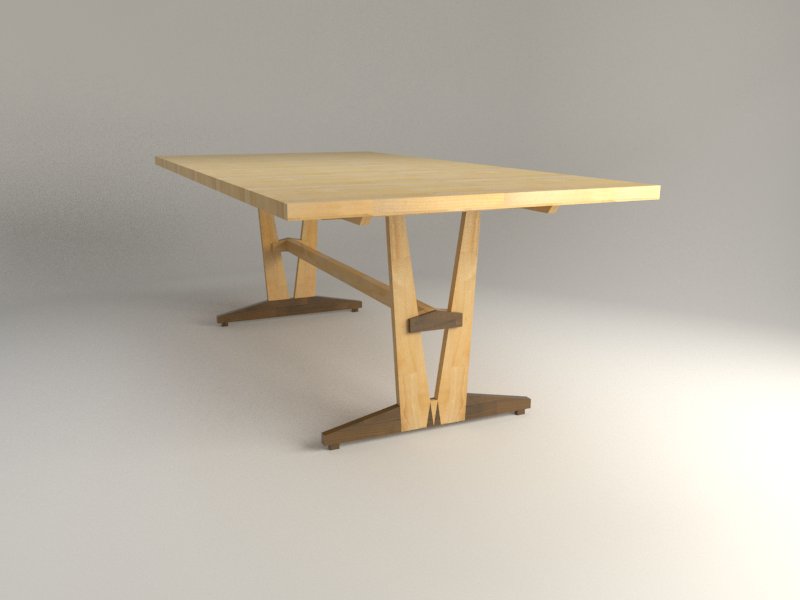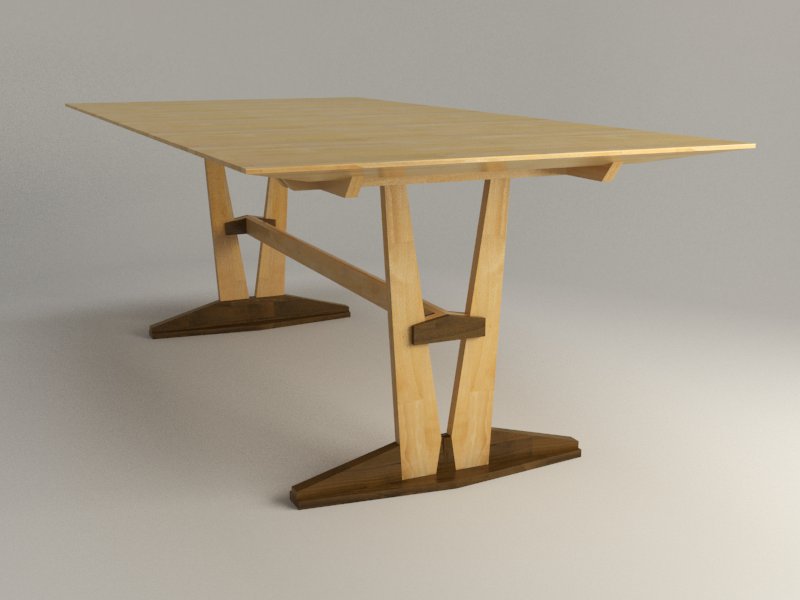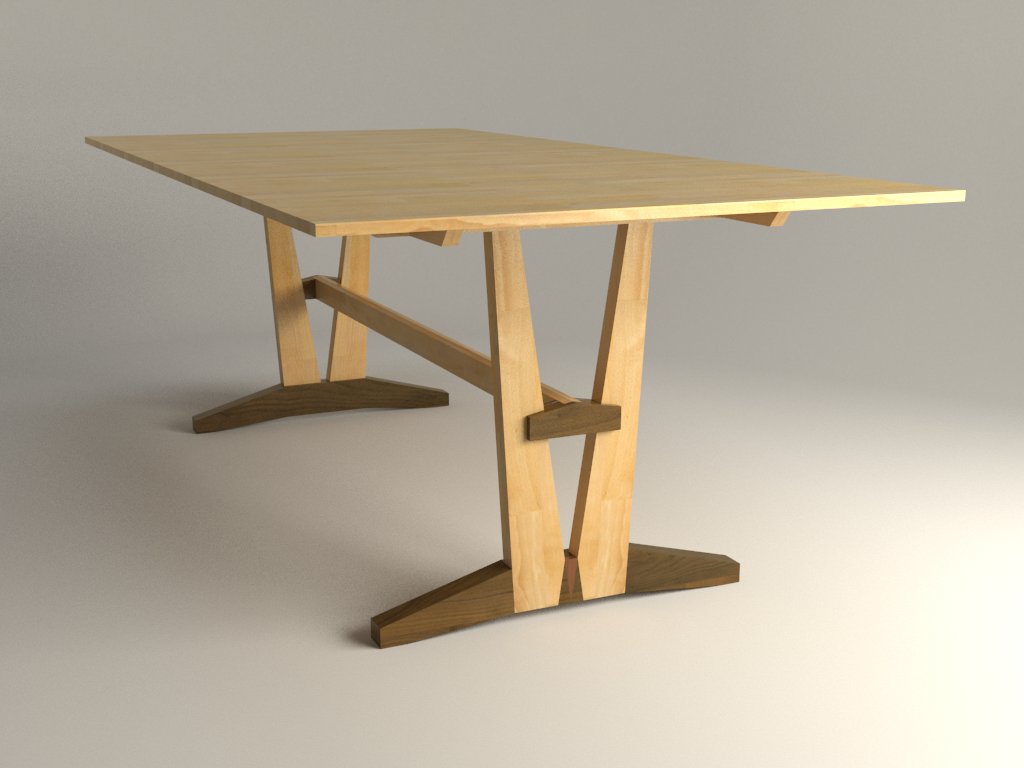WIP: trestle kitchen table
-
I like it but I agree with Michael. I would maybe make the feet thicker. Perhaps a bevel on the bottom edges of the top and angle the end of the caps on the stretcher to match the angles on the legs.
-
Thanks everyone! Appreciate the responses.
Michael, I did have in mind that there would be contrasting wood, specifically to differentiate some of the pieces. That's a good thought about the thicker feet, but I was thinking the verticals would be lapped over the feet. Here is an update with some changes to the materials. Dave, I like your idea of shaping the caps.

Oops, just looking at it again, I forgot about the bevel on the top. That is something I think would be worth doing. I'll do that next time I play with it.
-
That's coming along nicely. I'm thinking the feet should be thicker than the legs.
-
As usual, I agree with Dave (and not just because he agreed with me
 ). One other point I'll raise is about your choice of the butcher block top. Of course you can use any top you want to, but traditionally (at least according to Christopher Schwartz of Popular Woodworking, and some other things I've read) the tops of trestle tables are usually on the thinner side rather than thicker. When I see butcher block I want to see beefy 8/4 or 10/4 rectangular legs. Again, just one guys opinion. Keep us posted,
). One other point I'll raise is about your choice of the butcher block top. Of course you can use any top you want to, but traditionally (at least according to Christopher Schwartz of Popular Woodworking, and some other things I've read) the tops of trestle tables are usually on the thinner side rather than thicker. When I see butcher block I want to see beefy 8/4 or 10/4 rectangular legs. Again, just one guys opinion. Keep us posted,
Michael -
Thanks for the ideas! I really like the thinner edge, I see in the examples how it works well. I tried playing around with the feet having more weight to them. Here's an updated render.

With the butcher block top - actually the original idea for this table was just that - four solid legs in the corners. I wanted to see if there was something more stylish to do with the legs. The surface wants to be something that can take a beating with 3 young kids.
 Plus the counters will be the same material.
Plus the counters will be the same material. -
Nice.
I think the top is too thick even with the bevel. Simple maple boards glued edge to edge will make a nice durable top.
I didn't realize the feet are inverted Ts in section. How will you join the upright dark parts to the legs? Is it half-lap joints you have in mind? They appear to be the same thickness. It is that part that I was thinking should be thicker than the legs so you can mortise the legs into the base.
-
NICE. I Like the kitchen too, though one might need some respite from the color and I guess the cabinets aren't done.
I like the shape of the legs as seen on the near side of the last post. The shapes look less cut-off and more integrated. But, what would the joint be?
-
Peter, based on the that latest render, the joints would be half laps or as the Brits would say, halving joints.
-
Thanks Peter! Yes, Dave is right, the idea is a half-lap to emphasize the vertical. Quite right about the thinner top. Here it is with 1x boards. Might not need the edge bevel with this one, dunno. Tried another version with of the foot design as well.

-
Andy, the thinner top is better. I think about a 1/4-in. chamfer would be better on the top.
I like the idea of the half-laps but something bugs me about the foot assembly. I can't quite put my finger on it. Suppose the legs were thicker and so were the feet. Then get rid of the inverted T. I think it also looks flat-footed. How about cutting a very shallow vee in the bottom of the foot leaving pads about 2 in. long at the ends. That'll help to lift the table.
-
Still agree about the feet. 6/4 or 8/4 walnut is easy enough to source You could try a bridle joint to keep the maple visible if you wish. And I second Dave's notion to relieve the underside to create a samller footprint- much less dependant on a perfectly flat floor...but coming along nicely
-
Thanks for the ideas. Here's a revision with the relief under the feet and thicker wood for that piece. That's a good point that the foot may need more than a half-lap of wood continuing through, though with a thicker section it may work ok. I definitely like it better with more simple pieces than were I was going with adding the T to the foot.

-
Much better. I think your half laps will be just fine but you could do a really ninja thing and make them dovetailed.

-
Nice, I'll take one

-
Thanks guys! Much appreciated

-
Whenever I think of a trestle table, I always think of their ability to be knocked down.
You could do a real elegant job of this on this table by having the darker wood on the end of your stretcher mortised over the "v" legs. If the mortise were angled to match the "v", then as you pushed it down it would lock the legs in. Holes in both the stretcher end, and the leg could have pegs, and would really lock the them, particularly if the leg hole was slightly offset lower than a snug fitting stretcher.
Nice piece. -
Thanks Dale. I think I get what you are explaining about the added structural rigidity. I'm wondering since it's already triangulated, most of the forces are going be at the joint with the feet. (Acutally, which is a god reason in favor of a mortised connection instead of a lap connection... the lap could just "pop" out of joint if it's not secured well enough.)
-
I agree Andy, the more faces in a glue joint the stronger the joint. So if the mortise is shouldered, you have a potential 9 faces.
-
The mortise is what I suggested at first but I like the lap joint. Any faces which include end grain are basically write offs as far as strength so in a mortise and tenon joint you still really have only two good gluing surfaces. With the strength of glues today, the wood will be weaker than the glue joint I doubt you'd have any problem with the lap. If you wanted to maintain the the look of the lap (which I like) but you want to add some mechanical security to the joint in addition to the glue, you could do the dovetailed thing. Bevel the sides of the parts so the legs will only slide in from the top.
-
@dave r said:
Bevel the sides of the parts so the legs will only slide in from the top.
 Great idea, I like it! Now I understand what you mean about dovetailing. I was trying to figure out what the orientation of the dovetail would be. So this way, you would see the profile of the dovetail from underneath.
Great idea, I like it! Now I understand what you mean about dovetailing. I was trying to figure out what the orientation of the dovetail would be. So this way, you would see the profile of the dovetail from underneath.
Advertisement







